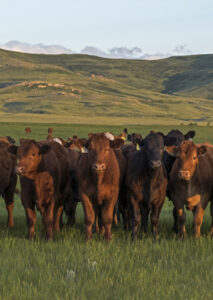Mycotoxins
Remarque : cette page web n’est actuellement disponible qu’en anglais.

A new webpage on BeefResearch.ca provides an overview of what mycotoxins are, the threat they represent for Canadian beef production and how to implement best practices to protect beef cattle.
Mycotoxins are often hidden hazards – a group of harmful toxins produced by certain types of fungi including mould that are only detectable with lab testing. They can create a variety of problems for beef cattle including reduced health and productivity.
The source of mycotoxins are fungi, including mould, that can be present in green pastures, cereal swaths, standing corn for winter grazing, cured and ensiled grass, cereal forages, crop co-products (straw, distillers grains, grain screenings, oilseed meals) and commercial feeds.
The most common causes of mycotoxin issues are fungal diseases such as fusarium and ergot. Risk of contamination is higher when moisture levels and temperatures are higher during the flowering stage and when storage conditions are less than ideal allowing moisture levels beyond recommended ranges.
Symptoms of mycotoxin poisoning in cattle:
- animals consume less feed; a feed reduction greater than 30% should be investigated
- a decrease in growth or performance, or a failure to thrive
- animal seems to be frequently sick, which may indicate immune suppression
- animal does not respond to antibiotics
- animal has convulsions, muscle spasms, temporary paralysis
- gangrene or lameness is present, especially in the animal’s ears, tail and feet
- animal has a fever, or has intermittent bloody diarrhea
- there are blisters, reddening, or ulcers in the mouth
- abortion and premature births occur, or reduced lactation
- fertility issues such as weak testicular development and low sperm count in bulls.
How to protect your cattle: The best options for producers are to simply not give mouldy feed to animals, to follow all best practices and precautions and to consider testing feed samples on a regular basis particularly when risk conditions are high. If you suspect mycotoxin poisoning in your herd, consult your veterinarian immediately.
Be aware that there is much debate in the industry about feeding guidelines, and the bottom line is that it is not clearly known what levels of mycotoxin are acceptable for feed. There is considerable variation among species. The age of animal you are feeding can vary the results. Some livestock specialists feel that even low levels of contamination can be harmful. More research needs to be done to further answer this question.
For more information view the new mycotoxins webpage.
Click here to subscribe to the BCRC Blog and receive email notifications when new content is posted.
The sharing or reprinting of BCRC Blog articles is welcome and encouraged. Please provide acknowledgement to the Beef Cattle Research Council, list the website address, www.BeefResearch.ca, and let us know you chose to share the article by emailing us at info@beefresearch.ca.
We welcome your questions, comments and suggestions. Contact us directly or generate public discussion by posting your thoughts below.
